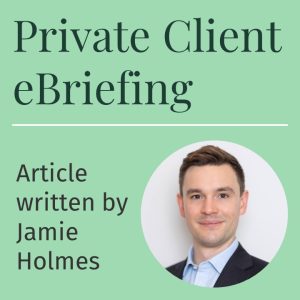Trusts, probate and estates: contentious, Trusts, probate and estates: non-contentiousThursday 28 March 2024
Tracing and cherrypicking: the decision in Lapome v Kemp and wider, recent trends
Article by Jamie Holmes, 19th March 2024
To read or download this article as a PDF, please click here.
- The decision of Master Brightwell in Lapome v. Kemp & Ors on 29 June 2023 (reported in summary at [2024] 1 P.&C.R. DG6) is a rare decision on a point of legal principle concerning tracing, in the context of a failed application to strike out the claim. Although of limited authority as a precedent, it is of interest to practitioners at two levels of detail.
- The basic facts as alleged, and which were assumed to be true for the purposes of the application, were as follows (see the judgment at [3]-[6]). The Claimant (“C”) was a company incorporated to buy a property in London. The first Defendant, Mr Kemp (“D1”), and another company of his, acted as agents for C in relation to that purchase. D1 entered into an arrangement with the seller of the property whereby (amongst other things) D2, a company wholly owned by D1, would earn a secret profit on the sale to C.
- C alleged that D1 so acted (amongst other things) in breach of fiduciary duty and that one or both of D1 and/or D2 were liable to account to C for the secret profit. The case accordingly falls in the category of ‘corporate cases’ that Lord Briggs referred to in Byers v. Saudi National Bank [2024] 2 W.L.R. 237 (UKSC) at [49] and [60]-[61].
- It was D1’s evidence that the profit was £322,660.26 and that this had been paid into an account in the name of D2 (judgment [7]-[10]). That account was said to be linked to a reserve account such that the two accounts should be treated as one for the purposes of tracing (judgment [9]), a position that was accepted for the purposes of the application. The result is that the lowest balance of this single ‘account’ was at all material times at least c. £1.3m (judgment [11]).
- By way of pleaded causes of action and relief sought, C pleaded (a) breach of fiduciary duty, and (b) knowing receipt (judgment [1], [4]), and sought a proprietary remedy in the form of assets or investments that it was anticipated that D1 and/or D2 had acquired or made using monies paid out of D2’s account (judgment [12]-[13]). Whether D1 and/or D2 had so acquired any such asset or investment (and/or what the value of that now stood at) appears to have been an open question at the time of the application. It is unclear to the author whether any alternative remedy was sought in the form of a lien or personal money claim.
- The question for the Court was whether it was open to C to seek to trace into such assets as may have been acquired with the monies in the account, in circumstances in which there were at all material times sufficient assets in that account to meet C’s claim. Did the tracing process allow C to ‘cherry pick’ between these two (or more) potential rival substitutions, or could C only claim against the money in the account (judgment [2])?[1]
- Tracing is neither a claim nor a remedy. It is an evidential process. Its purpose is to supply an answer to the question of what asset(s) (if any) can be treated by the Court as a substitute for the asset that was originally subject to the trust in question. Strictly speaking: can the value inherent in the original asset be ‘traced’ into another asset? On this issue the claimant generally bears the burden of proof and must establish a sufficient transactional link at each stage, or that various stages form part of a co-ordinated scheme.[2] It may be appropriate, in certain circumstances, to resolve that inquiry by making inferences of fact.[3]
- The tracing process is itself also subject to a number of legal rules. These rules vary depending on a number of aspects of any given case. In particular, the present case concerned (a) the equitable tracing rules. Further (b) the attempted substitution into or through the bank account in this case was not a ‘clean’ substitution of the value in one asset for another of the same value (as might apply to a purchase of goods), but a ‘mixed’ substitution where the value in the account had come in part (indeed on these facts had mostly come from) D1 and/or D2. On the other hand (c) there were no innocent parties to consider, D1 and D2 being in the position of a trustee and/or another wrongdoer recipient.
- The two primary legal rules in this context are supplied by the decisions of Re Hallett (1880) 13 Ch. D. 696 and re Oatway [1903] 2 Ch. 356; both as summarised in the judgment at [15]. Hallett allows a claimant to say that the trustee/wrongdoer has spent their own money first, leaving that still in the account for the claimant (this being particularly useful when the asset(s) have otherwise been untraceably dissipated), although the claimant is (generally) unable to trace beyond the lowest balance of the account at any time following the transfer of the trust money into that account. Oatway allows a claimant to say that the trustee/wrongdoer has spent trust money within the account to purchase an asset against which the claimant can now claim (this being particularly useful when the account is now empty and/or that asset has increased in value beyond the original claim). Could C in the present case rely on Oatway, in circumstances in which Hallett (also) applied?
- D1 and D2 said that the answer to this question was settled as a matter of law by the ratio of the decision of Patten J (as he then was) in Turner v. Jacob [2008] W.T.L.R. 307 and applied to strike out C’s claim (judgment [1]-[2], [14]). Turner was said to be authority for the proposition that C could not trace beyond what remained in the account.
- The Master dismissed the application: judgment [31]-[37]. The summary of the relevant authority and commentary on the point is at judgment [16]-[30]. This includes in particular consideration of (a) the dicta of Rimer J (as he then was) in Shalson v. Russo [2005] Ch. 281 at [144], to the effect that it was open to a claimant to so cherry pick. Further, (b) of the decision of Calver J in ED&F Man v. Come Harvest [2022] EWHC 229 (Comm) which considered Shalson and Turner,[4] although it is unclear that the Master drew any assistance from it, having distinguished it in a number of respects at judgment [28]-[30].[5]
- The decision in Lapome is of interest to practitioners at two levels of detail.
- First, as to what it has to say concerning this particular legal rule, being one of the various legal rules of the evidential tracing process. The Master held that C had established at least a real prospect of success that the trial judge would ultimately find that they were not bound by what D1 and D2 had submitted to be the ratio of Turner (judgment [32]). There are three or four strands to the reasoning. First (i), on one reading, Turner was authority only that C was limited to tracing into the first asset so purchased (judgment [18], [34]). Further, it was “very relevant” both (ii) that Patten J had not been taken to the dicta in Shalson or to certain passages in Foskett (both cited above), and (iii) that the predominant view of academic commentators was that the law was not settled and/or that the dicta in Shalson were to be preferred (judgment [33]). Further, (iv) there were potentially points of distinction to Turner on the facts, which should be explored at trial (judgment [32]-[35]). Overall, the point was a “controversial question” for trial and not necessarily determined by Turner (judgment [31], [36]).
- On the other hand, the Master was not prepared to find that C had the better of the argument on the point: there were “strong arguments that the right to cherry pick should not be unfettered” and “It seems to me likely that if cherry picking is allowed, there may be some temporal limit on it” (judgment [34] and [37]). As the Master noted, there is some support for the latter in both Turner and Shalson, although it is not clear that Rimer J intended in Shalson to refer to more than the effect of the general ‘lowest balance’ rule (as above).
- Secondly, Lapome is consistent with a wider trend in decisions on tracing in recent years. Decisions on legal points of principle concerning tracing (such as those referred to at paragraphs 9-12 above) have been few and far between. The leading cases have concerned issues such as the governing law, whether inferences of fact can be drawn and/or the burden of proof reversed (see e.g. AHAB v. Saad, cited above), and have tended to decline to set down further hard-edged legal rules limiting the tracing process as a matter of principle (see e.g. Durant, cited above). Instead, the nature of the tracing process as turning on the evidence and facts in each case has been emphasised. Lapome is consistent with that picture, even if it is ultimately of limited authority as the decision of a Master[6] that a claim should not be struck out.
For more information:
The views expressed in this material are those of the individual author(s) and do not necessarily reflect the views of Wilberforce Chambers or its members. This material is provided free of charge by Wilberforce Chambers for general information only and is not intended to provide legal advice. No responsibility for any consequences of relying on this as legal advice is assumed by the author or the publisher; if you are not a solicitor, you are strongly advised to obtain specific advice from a lawyer. The contents of this material must not be reproduced without the consent of the author.
[1] The phrase ‘money in the account’ is used as a convenient shorthand by the author for the chose in action against the bank for the credit balance of the account. See e.g. Brazil v. Durant [2016] A.C. 297 (JCPC) at [26]-[27]; citing a passage from the speech of Lord Millett in Foskett v. McKeown [2001] 1 A.C. 102 (UKHL) at 127-8.
[2] Durant (cited above, JCPC), [32]-[34], [38], [40] and [42].
[3] See for example AHAB v. Saad [2021 (2) CILR 704] (Cayman Islands Court of Appeal or ‘CICA’), at [891]-[900]. See further thereafter the consideration of the circumstances in which it may be permissible to reverse the burden of proof: at [901]-[929], applied at [942]-[953], and summarised at [1087.(vii)-(ix)].
[4] The author is aware of only one other authority in which Turner has been cited, that being the passing comment in HCS v. Tahir [2021] EWHC 3499 (KB) at [3] and [63]-[65], per HHJ Kramer (sitting as a High Court Judge).
[5] The key points of distinction are summarised by Calver J himself at [679]-[685]. See also [62] and [646].
[6] Michael Ashdown, Precedent value of Chancery Masters’ decisions





